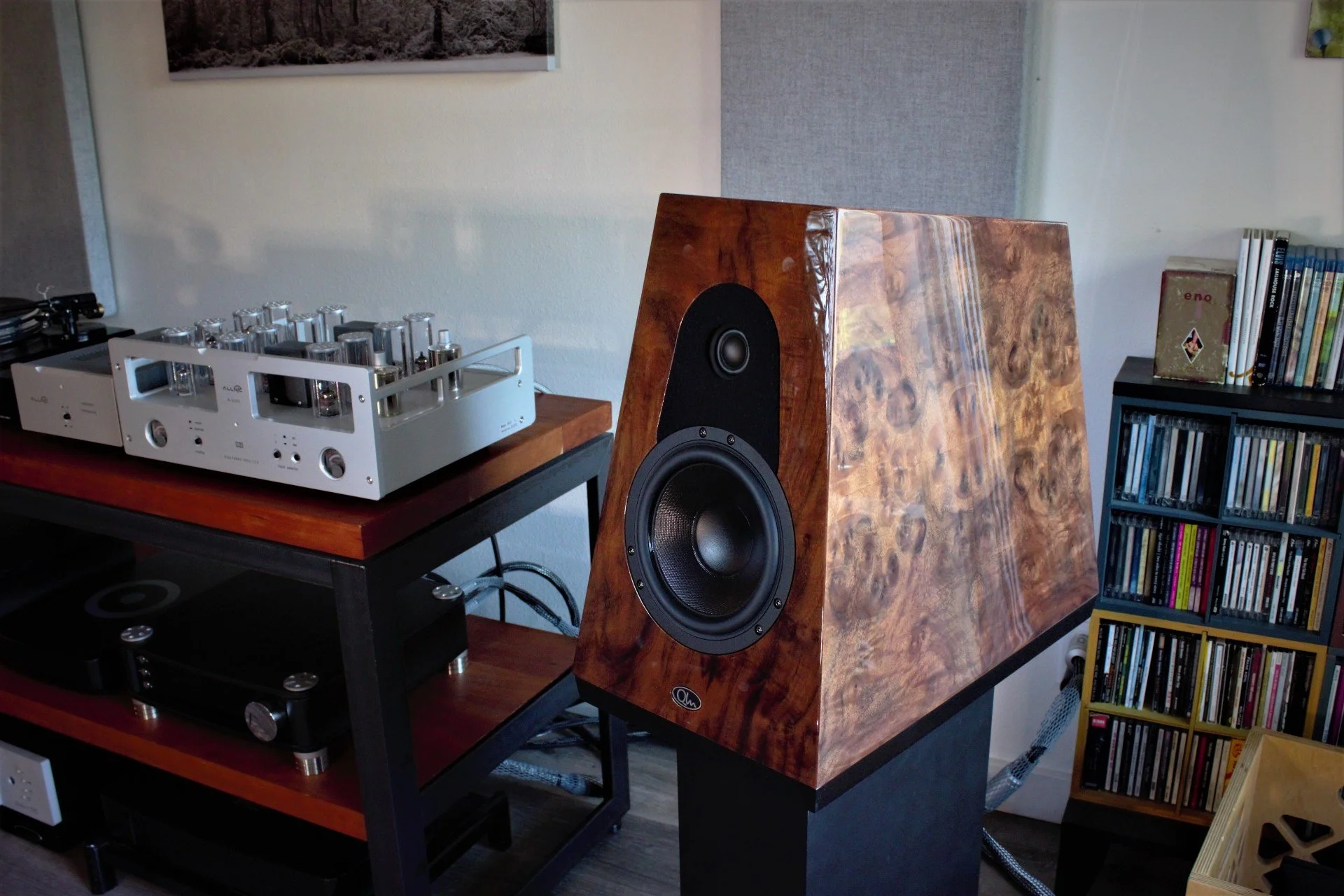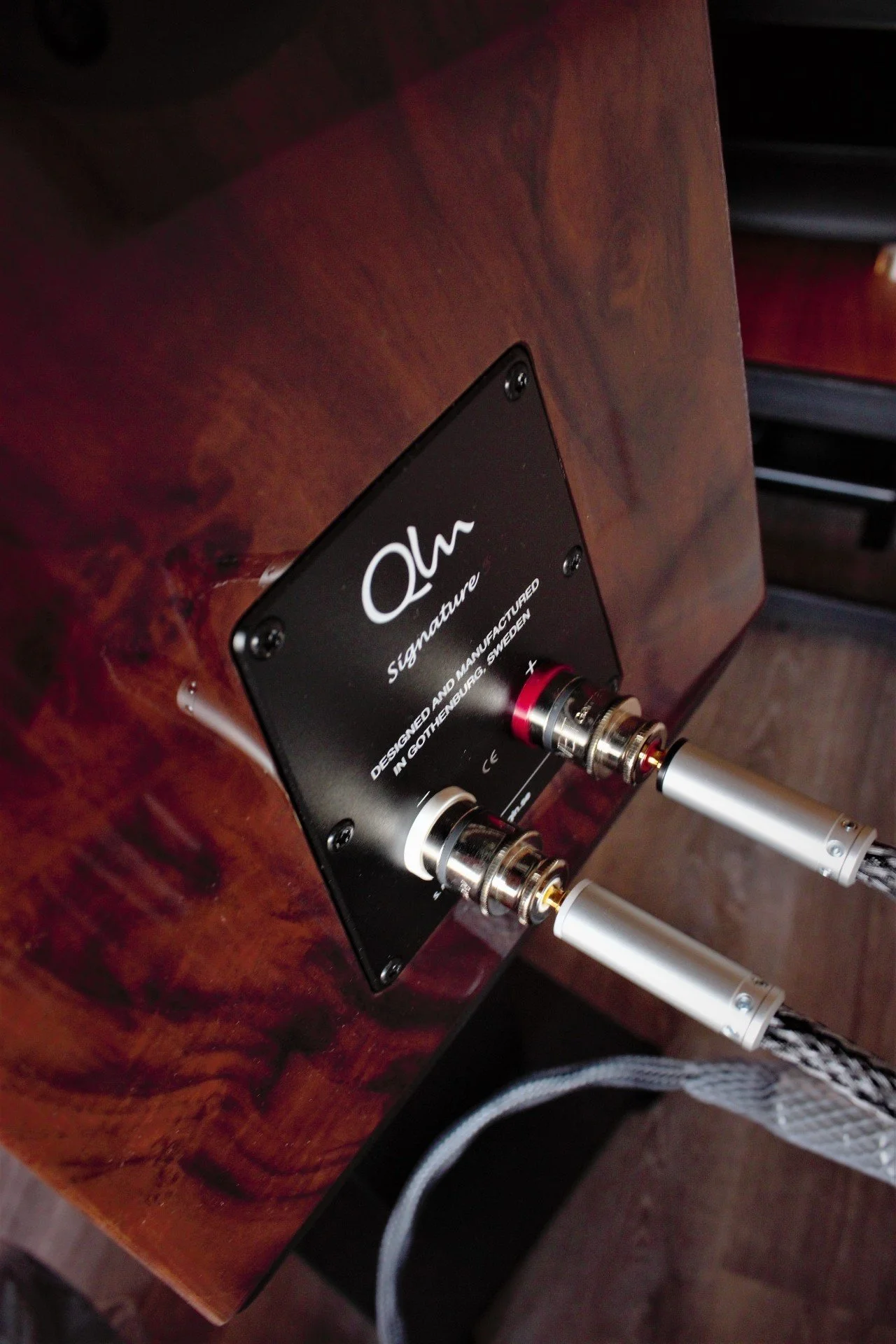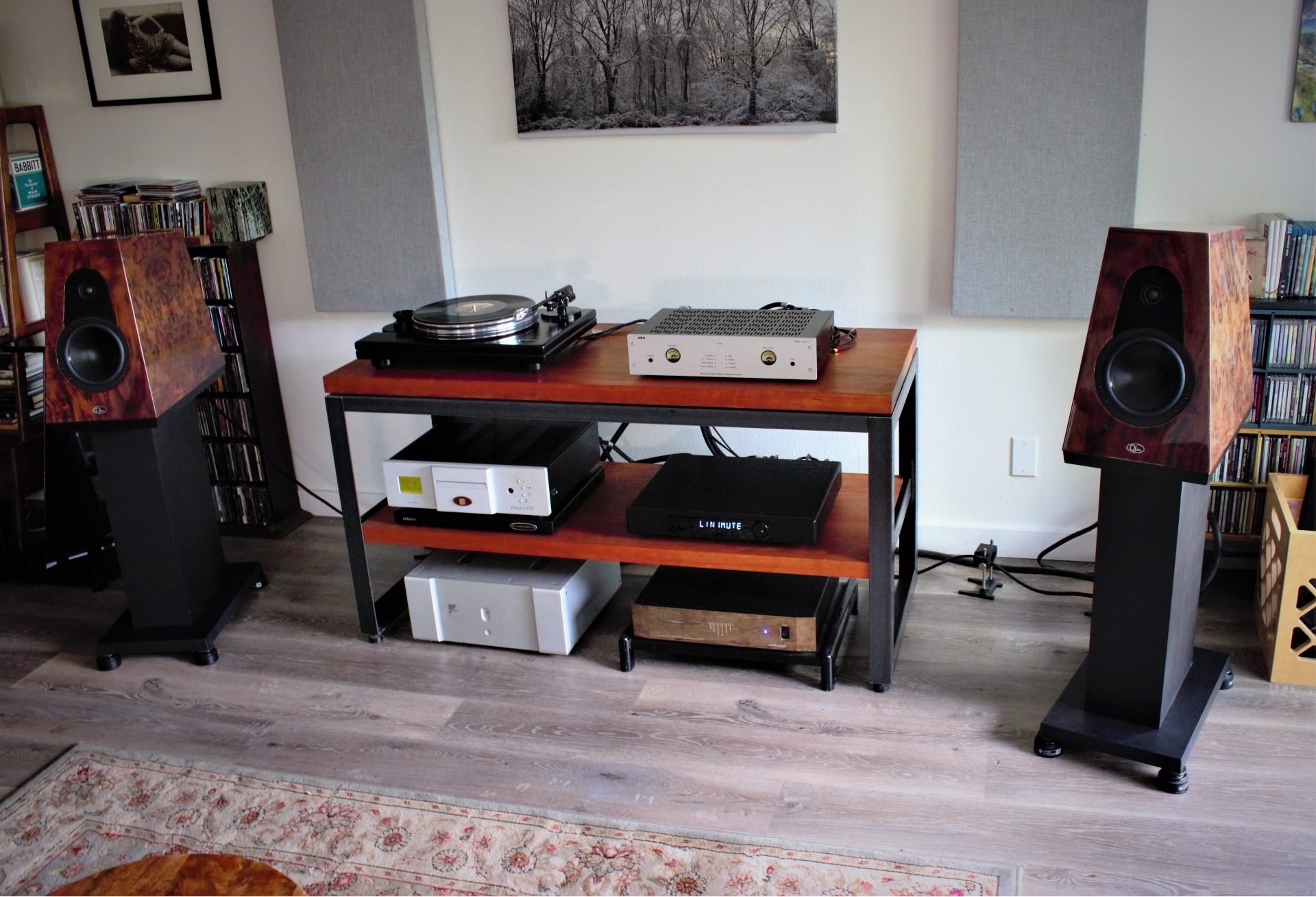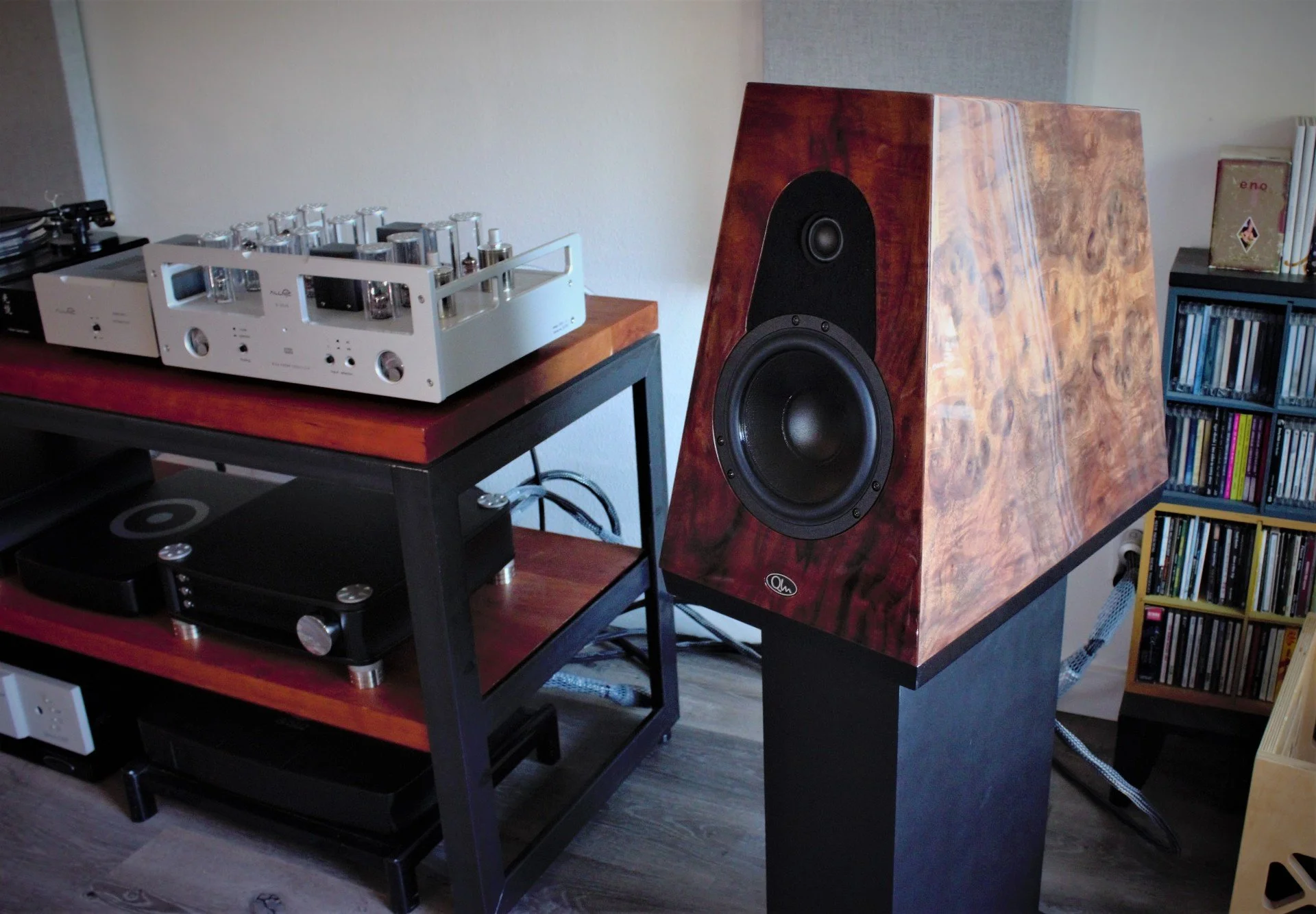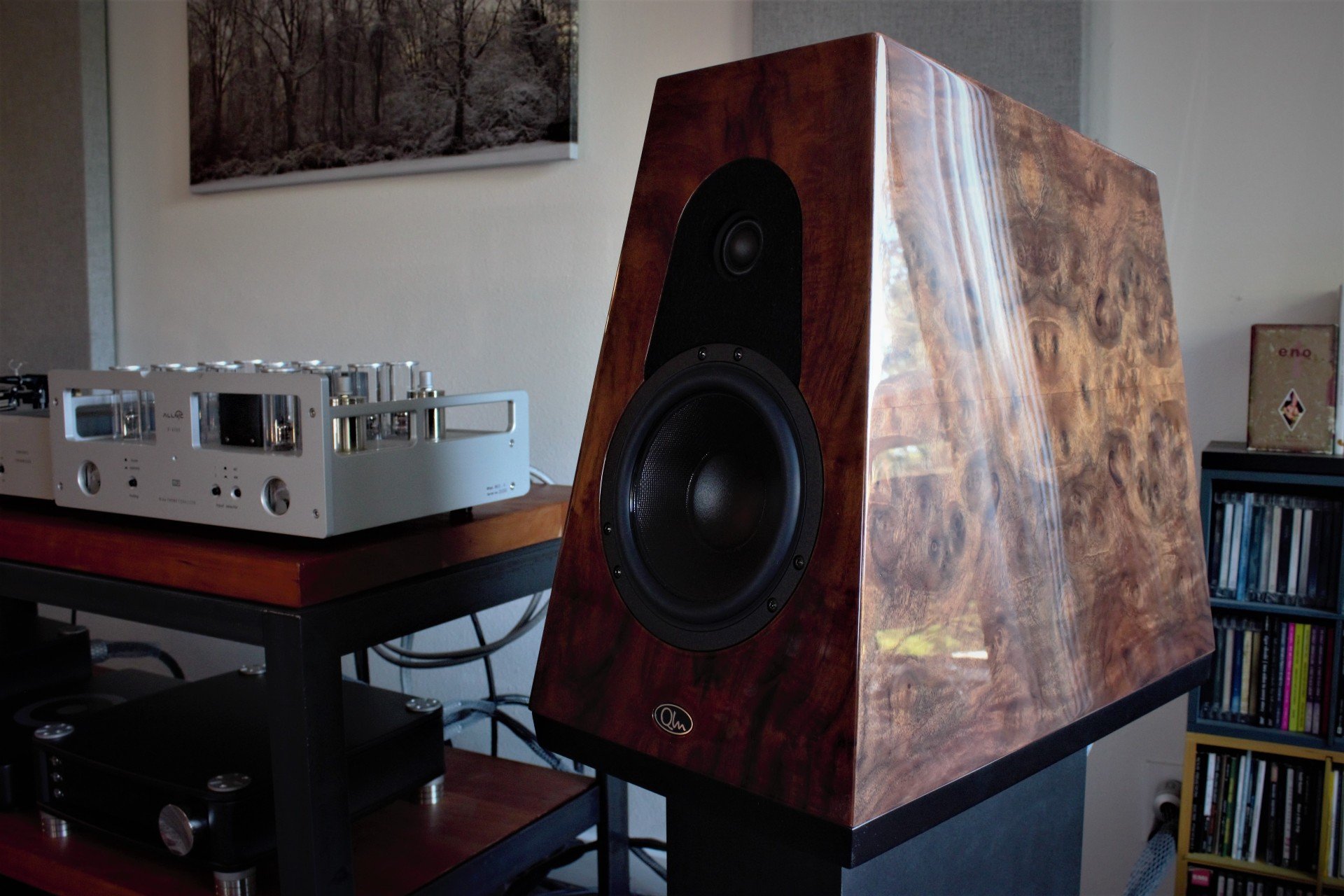Spoiler alert: this isn’t going to be as much of a dry, objective review of the Qln Signature loudspeakers as a feverish chronicle of an all-too-brief romance. If that seems too biased for a high-end audio review, so be it. In this hobby, we often keep our enthusiasms on a short leash lest people think we’ve surrendered that objectivity. I say that if you find something that seems to have been tailor-made to your personal tastes and gets you all pumped up, tell the world.
Let me once again preface this by reminding my critics that I don’t “love everything” and the reason why most of my reviews are positive and end in a solid recommendation is because I often do a lot of scouting in advance. There’s nothing that takes the fun out of this otherwise amazing job quicker than a piece of gear that holds no interest for me and isn’t remarkable in one way or another, and I think both readers and manufacturers know what it looks like when a reviewer is trying too hard to say something positive about said piece of gear. I want it to be interesting to me, because I want it to be interesting to the readers. Otherwise this becomes just a dreary job, like all the others.
But I didn’t just scout the Qln Signature monitors. I stalked them, and for quite a while. I charted their progress through the production channels. I knew how good they were long before they arrived on my front porch. Heard them a couple of times in advance. Wrote about it, too.
Let’s go back to the beginning. After I reviewed the Qln Prestige One monitors a couple of years ago, I couldn’t stop thinking about them. These two-way monitors cost just $6,800 pr USD, and yet I preferred them to some of the five-figure premium two-way speakers I’ve reviewed. That’s troubling since the Prestige Ones have influenced the way I now judge speakers in this price range because I know what can be done for this kind of money. You, my $7,000-loudspeaker-making-friend, have to beat this.
I’m not saying that the Qln Prestige Ones are the best stand-mount two-ways in the world, but if you hand me $7,000 and say go forth and buy a pair of two-ways, I will probably be quick and decisive and give Mats Andersen of Qln and Mark Sossa (of Well-Pleased Audio Vida and the Sales Manager for Qln) a quick phone call and tell them I’m ready to pull the trigger. But what if Mats Andersen did decide to build the “best” two-way that he could, something that goes far beyond the remarkable Prestige Ones? Just before my review period started with the P1, I was told that Mats was working on the latest generation of his original Signature monitor, which was the Qln flagship model for a long time. (Remember, Qln has been around since the ‘80s.) Best part: when it was ready, I’d get a chance to review it.
Here we are, all caught up. But this recent refreshening of the Qln speaker line was, at first, tough to sort out. The original Signature model actually looks a lot like the Prestige One—a truncated pyramid, basically. The original Prestige One, in fact, was just a rectangular box with all right angles. When I first opened my review pair of the Prestige Ones, I thought they were the new Signatures with that same geometric shape. That’s when I realized that I hadn’t even seen an image of the new Qln Signature yet. No one had.
Once I saw them in the flesh, at AXPONA, everything made sense. While the Qln Signature loudspeakers bear a strong resemblance to its siblings in the Prestige line, they make a strong first impression with their size, shape and the quality of their fit and finish. There’s no mistaking that this elegant and substantial monitor is designed to sound like a much bigger speaker, one with few limitations.
I know, that’s another expectation I had about the Qln Signature monitors. Still, I felt the electricity in the air when we first met. The chemistry was undeniable. And it helped that they looked hawt.
Qln Signature—the Meet Cute
Oh my God, is that them?
When I arrived at AXPONA 2022, my top priority was visiting the room where the Qln Signatures were ready, along with the Vinnie Rossi Brama integrated amplifier, to make their public debut. They looked amazing, a Qln through and through in terms of shape, drivers and finishes, but really, really deep. That depth, in turn, makes the Qln Signature look absolutely huge in comparison to the Prestige One, even though they look very similar when both are faced straight on.
Also, there are no right angles in this enclosure. You still have that truncated pyramid shape of the P1, but the top of the cabinet slants down so there are no parallel surfaces creating standing waves and other sonic mischief. That also adds to the perception of depth.
How much do they cost?
There was a time when that question made me cringe, because that’s always the first question someone asks when they’re exposed to a high-end audio product. We have a couple of writers at PTA who never talk about price tags—I gotta chase them down for the price before publication because the angry comments will be immediate and numerous if I don’t. But I was interested in the final MSRP of the Qln Signature for a couple of reasons. First, the PTA staff constantly talks about Qln, and we all made our guesses about the MSRP of the Signature. Second, I wanted to know if the price was within my reach, because…well, it’s a Qln, that’s why.
The final price for the Qln Signature monitor is $22,000 per pair in matte walnut (the pair I heard in AXPONA), and $24,000 per pair in the breathtaking gloss walnut burl (the pair I saw in Munich, which is the pair I wound up reviewing). The dedicated stands will be an extra $2,000 per pair. That’s significantly more expensive than the three-way floor-standing Qln Prestige Fives at Dave McNair’s house.
I asked Mats Andersen which model he liked better, and he was a kind and fair father when he said the P5s go deeper in the bass, but there was something very special about the Signature that goes beyond frequency response. To this day, I still haven’t listened to the Prestige Fives.
The Qln Signature uses a custom 7” Kevlar driver from Scanspeak and an Illuminator tweeter from the same source. Mats told me, back in Munich, that he prefers using “soft” drivers—as opposed to metal or ceramic—because they provide the sound he wants. These drivers from Scanspeak are custom-made for the Signature, however:
“The Qln developed coated Kevlar® bass/midrange driver with under hung magnet system (where the voice coil is in the magnet gap all the time) forms a completely linear motor system. This allows for open air flow without any compression or turbulence resulting in micro details and absence of acoustic noise found in normal basket designs. A built-in copper ring in the magnet system offers symmetrical drive, and lower voice coil inductance producing higher dynamics in the midrange while also suppressing intermodulation distortion. All these technical innovations result in astonishing micro/macro dynamics from a 2-way speaker design.”
The first couple of times I heard Qln speakers, I wondered how Mats Andersen achieved such a rare and beautiful sound from a seemingly conventional enclosure and driver complement and I might’ve mentioned something about fairy dust to Mark Sossa. He replied that it’s all exceptional engineering and attention to design. When you look at the Qln Signature and what’s inside, you’ll start to appreciate the thoroughness of its creator.
Mat Andersen’s constant impedance crossover has been redesigned with non-inductive capacitors, and the internal cabling uses pure copper core that’s manufactured right there in Sweden. Parts quality is extremely high—copper film caps, precision metal film resistors and WBT Nextgen binding posts with silver-plated copper. The enclosure itself is made from QLN’s proprietary Qboard material, which eliminates “structural resonances in the acoustic chamber.” The slanted baffle allows time alignment of the drivers. Every step of the way, Mats is finding new ways to eliminate noise.
Finally, let’s take a look at the Qln Signature’s numbers: 87 dB sensitivity at 8 ohms, a frequency range that goes down to 38 Hz (down 3 dB), seemingly ordinary numbers for an extraordinary transducer. The number that wound up meaning the most to me was the weight—31 kg, almost 70 pounds. They’re two-way bookshelf monitors, but just barely. Lift with your legs.
Qln Signature—the First Date
When the Qln Signatures were first installed, they were connected to my Pureaudio Control preamplifier and an older Ayre V-3 power amplifier I’ve borrowed. That was a superb match, with just the right amount of warmth—a “getting to know you” kind of warmth that may have been a little reserved in tonality but still hosted a very entertaining party at the frequency extremes. Then I moved to the Bel Canto Design e1X integrated amplifier, a powerful class D “almost all-in-one” with an inboard phono stage and DAC/network streamer. I had nearly everything I wanted sound-wise, coupled with a dizzying array of source options that prompted many a late-night listening marathon.
Then the Aavik and Ansuz equipment arrived—the Aavik U-280 integrated with built-in DAC, the Aavik S-280 music streamer, the Ansuz ethernet switch and power distribution, and plenty of Ansuz cabling from speaker cables to interconnects to power cords to USBs to ethernet. If you’ve read about my recent visit with Audio Group Denmark, you’ll know this gear is very different than most in its approach. For example, each of the three brands in AGP (Aavik, Ansuz and Børresen) focus on reducing inductance in the signal path in order to reduce the noise floor. These pieces created such a profound silence around the music that every other component has its nature revealed, warts and all.
At first I wondered who would win—the utter neutrality of AGD, or that warm and intoxicating Qln dreamscape. Turns out, the Qln Signatures were more neutral than I thought. As I mentioned, Mats is focused on reducing noise and unwanted resonance, and that’s totally aligned with the AGD approach. I could still feel the Signatures’ serenity and poise within the AGD-dominated system but pulled in a little closer to the sweet spot. Hearing this combination thrive, with the support of the other, truly reinforced that idea of warmth and detail being totally compatible. Depending upon the music, I could focus on the tiniest details or drift back and lose my focus and get lost in the music.
Finally, the Qln Signatures have those dedicated stands. (Mine were prototypes of the final version, by the way.) With that massive weight, they need them. I was able to use the Acora Acoustics SRS-G stands on the Prestige Ones and they took the low frequency performance to the next level. But the Qln Signatures are so large, especially on the bottom, that the top plate for the SRS-Gs seemed like a precarious solution for such a robust monitor. So Mark Sossa sent me the stands for the Signatures, along with some additional magnetic damping footers to try from Levar Resonance.
Yes, I said magnetic damping footers. That means the Qln Signatures were actually floating on a cushion of air, which is okay since the Levars are self-leveling. Mark sent me the 16s—a set of four will handle up to 52 kg. (Other models from Levar handle up to 200 kg.)
Installation was a brief white-knuckler until the Levars settled in and self-leveled—the entire structure was a little wobbly and the Signatures, as I mentioned, are not light speakers. Eventually the footers stabilize, and that’s when I stopped worrying. The Qln Signatures undoubtedly sounded better on the Levar Resonance 16s than on the nicely-finished stock footers supplied by Mats Andersen. Low frequencies had greater force, as well as greater focus, and I heard more detail. While I’d still be careful not to bump the stands with my hindquarters, I would choose the Levars with these stands without hesitation.
Listening to Music…Together
You know when you first meet someone you really like and it seems like you have so little time to tell them everything you want them to know? With the Qln Signatures settled in, it was almost a race to see how much of my favorite music I could play through them. The Aavik U-280 and S-280 allowed me to stream like a demon through my musical history (as did the Bel Canto Design e1X before it), and these were days when notes weren’t scribbled down and personal hygiene was briefly suspended. But you know what I mean. I felt like I was hearing the best version of many of my favorite tracks, and time was running out.
Plenty of new releases were given the Qln treatment. Nica Carrington’s Times Like These is a rather natural choice where we have a jazz singer with a tremendously expressive voice, just a hint of dryness in the chest to add a little character, backed by a stellar piano trio. I’ve heard a lot of contemporary jazz recordings that fit this description—female voice, intimate jazz, covers from the Great American Songbook—but this recording is exceptional, and somewhat warm on its own.
This is where the concept of warmth, Qln style, comes into play. I didn’t hear warmth layered upon warmth. The music was still balanced, clear and still seductive. But remember how I mentioned that touch of dryness in Nica Carrington’s voice? With a lesser speaker in the mix, you might think you were hearing a speaker that was slightly dry in the midrange. The Qln Signatures, however, let you know clearly that this comes from the singer’s heart and soul and vocal cords. It’s honest and real and still mesmerizing.
Another revelatory listening moment was provided by Kane Mathis’ extraordinary Geminus album, where he leads a jazz trio with a kora and an oud. It’s an exotic, dense sound that shoots out from the speakers and lands all over your body and gives you goose bumps. This isn’t a knock on the dispersion characteristics of the Qln Signatures, or that they’re not ideal for off-axis listening, but I was playing Geminus one day and I rounded the corner into the listening room, taking a few steps until I was in the sweet spot, and I experienced one heck of an adrenaline rush as the soundstage quickly focused and took its shape. There was such a profound change in the sound after just a few idle steps that I was reminded of all those times when I walked into a room with Vinnie Rossa amps and Qln speakers and melted when I heard how deep that soundstage ventured far beyond the rear wall, and how everything within that vast space is focused and smiling at me.
The Qln Prestige Ones captured a lot of that feeling, but I also felt that the Vinnie Rossi amps must have been supplying that extra spellbinding 3-D landscape. The Qln Signature, however, didn’t need as much assistance to reach that lofty sonic goal. Yes, I’ve heard the Signature with the Vinnie Rossi Brama integrated amplifier, and it was one of the finest hours I’ve spent in an exhibit room at a high-end audio show. I was finally achieving that wonderful sound in my home with the Qln Signatures, and I was doing it with class D amplification.
Qln Signature—the Sad Goodbye
Can you tell I loved the Qln Signature monitors? I did. But after listening to such an exquisite, powerful and lovable transducer, one that provided nearly everything I could possibly want from a two-way “bookshelf” monitor, questions are raised about the Qln Signature’s place in the loudspeaker hierarchy. I hate making comparisons like that because they’re usually so fraught with error, but I did have several people ask me how they compared to the Vimberg Amea—our 2020 Product of the Year and my choice, at the time, for the finest two-way monitor I’d heard up to that point. In addition, I have all that seat time with those expensive yet mind-boggling little Borresens—the Z1 Cryos landed at my home as the Qln Signatures were getting boxed up and sent to the 2022 Capital Audiofest.
At this point, there are probably less than five two-way monitors I’ve heard that truly sound like a large floor-stander. The Ameas are one, the Borresens are another, and now we have the Qln Signatures. (I’ve just noticed that Germany, Denmark and Sweden are all very close together. Hmm.) While many audiophiles generally look down their noses at two-way monitors in terms of achieving state-of-the-art sound, they do so without a blindfold. The Qln Signature monitors are a wake-up call to that type of thinking.
The Qln Signatures make no apologies. They sound big and full and detailed and warm and once again I’m not so sure I need anything more to be happy. There is a question of how the Signatures would perform in a huge room, but I don’t have a huge room. I have a normal room and the Qlns reign supreme and ask nothing of me but my undivided attention. Which they have. Highly recommended.

